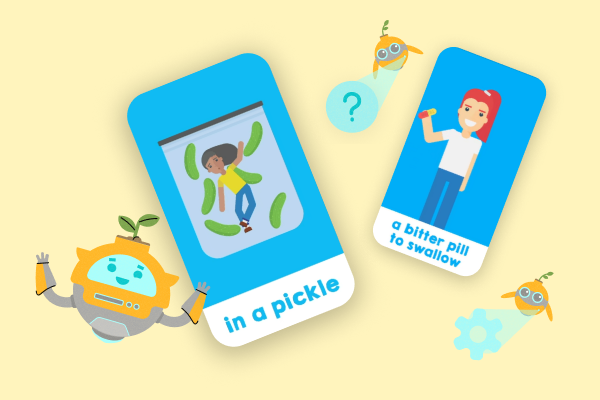

If you’ve ever told a child to ‘hold their horses’, ‘break a leg’ or ‘bite the bullet’, you’ve used an idiom. These phrases are a colourful part of adding personality and humour to everyday language. But for anyone learning English as an Additional Language (EAL), idioms can be downright baffling.
So where do these strange sayings come from, and why do they make language learning so tricky?
What actually is an idiom?
An idiom is a phrase where the meaning isn’t obvious from the words themselves. You can’t work it out by translating each word. If someone ‘spills the beans’, no legumes are involved. If it’s ‘raining cats and dogs’, you probably just need an umbrella.
Idioms appear in almost every language and are often deeply rooted in culture. They help bring colour and expression to communication, but they can be confusing for language learners. In English, idioms are everywhere in both spoken and written forms. Native speakers use them without thinking, often unaware of how odd they sound to anyone who hasn’t grown up with them.
For EAL pupils, idioms can be a real stumbling block. They confuse literal learners, don’t always translate well and are rarely explained in traditional vocabulary lessons.
A quick trip into the history of idioms
Idioms often have roots in history, culture and even superstition. Here are a few favourites and where they may have come from:
- Pulling your leg: This may have originated from Victorian street thieves who would trip people up and steal from them as they lay on the ground.
- In a pickle: This dates back to the 1500s and was popularised by Shakespeare in The Tempest. Originally, it referred to being mixed up in a spicy brine, which was not a pleasant place to be. It became a fitting way to describe a difficult or uncomfortable situation.
- A bitter pill to swallow: This comes from the time when medicine often tasted unpleasant. Bitter pills were hard to take but necessary, much like difficult truths or situations we have to accept.
- Break the ice: Likely inspired by ships needing to break through frozen harbours to get moving, this idiom is now used when easing tension or starting a conversation in a social setting.
- Chip off the old block: Used to describe someone who closely resembles a parent, especially in personality or behaviour. It comes from the idea of a piece of wood or stone being chipped from a larger block, still clearly part of the same material.
The idiom challenge for EAL learners
Because idioms rely so much on cultural understanding and figurative meaning, they can leave EAL pupils scratching their heads. A pupil might know the words ‘cold’, ‘shoulder’ and ‘give’, but still have no idea why being given the cold shoulder means they’re being ignored.
This is where traditional vocabulary lists fall short. Without context, idioms don’t make sense. And if you’re not confident speaking English yet, it’s hard to ask what something like ‘kick the bucket’ really means.
How FlashAcademy® helps make sense of idioms
To support EAL pupils through this challenge, FlashAcademy® includes a dedicated section on idioms. It introduces commonly used idioms through animated flashcards, showing both the literal and figurative meanings. Pupils then complete activities to help them understand, remember and use each idiom correctly.
Every idiom ends with a listening comprehension challenge, helping learners hear idioms in context and build confidence using them. Because the lessons are visual and interactive, they’re easier to remember than just reading a definition.
Idioms don’t have to be a pain in the neck
Idioms might be strange, illogical and often quite funny, but they’re also an important part of learning English. With the right support, pupils can go from puzzled to proficient, and even start enjoying the quirky side of language.
If you’d like to learn more about how our idiom lessons work, get in touch for a quick demo of FlashAcademy®.

